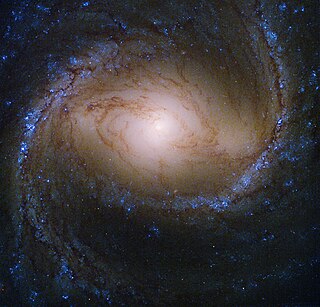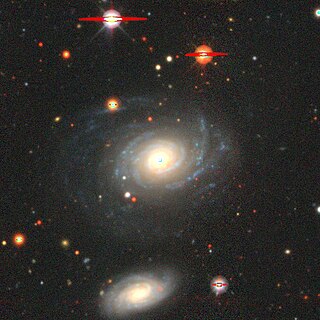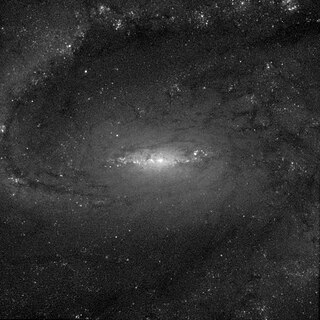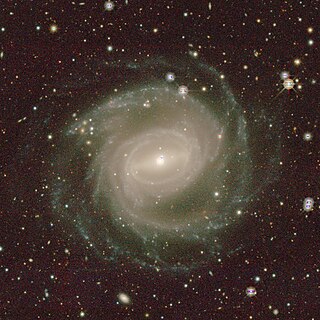
Virgo is one of the constellations of the zodiac. Its name is Latin for maiden, and its old astronomical symbol is . Between Leo to the west and Libra to the east, it is the second-largest constellation in the sky and the largest constellation in the zodiac. The ecliptic intersects the celestial equator within this constellation and Pisces. Underlying these technical two definitions, the sun passes directly overhead of the equator, within this constellation, at the September equinox. Virgo can be easily found through its brightest star, Spica.

Coma Berenices is an ancient asterism in the northern sky, which has been defined as one of the 88 modern constellations. It is in the direction of the fourth galactic quadrant, between Leo and Boötes, and it is visible in both hemispheres. Its name means "Berenice's Hair" in Latin and refers to Queen Berenice II of Egypt, who sacrificed her long hair as a votive offering. It was introduced to Western astronomy during the third century BC by Conon of Samos and was further corroborated as a constellation by Gerardus Mercator and Tycho Brahe. It is the only modern constellation named after a historic person.

Hydra is the largest of the 88 modern constellations, measuring 1303 square degrees, and also the longest at over 100 degrees. Its southern end borders Libra and Centaurus and its northern end borders Cancer. It was included among the 48 constellations listed by the 2nd century astronomer Ptolemy. Commonly represented as a water snake, it straddles the celestial equator.

Messier 91 is a barred spiral galaxy that is found in the south of Coma Berenices. It is in the local supercluster and is part of the Virgo Cluster of galaxies. It is about 63 million light-years away from our galaxy. It was the last of a group of eight "nebulae" – the term 'galaxy' only coming into use for these objects once it was realized in the 20th century that they were extragalactic – discovered by Charles Messier in 1781. It is the faintest object in the Messier catalog, with an apparent magnitude of 10.2.

NGC 1 is an intermediate spiral galaxy of the morphological type Sbc, located in the constellation of Pegasus. It was discovered on 30 September 1861 by Heinrich d'Arrest.

NGC 278 is an isolated spiral galaxy in the northern circumpolar constellation of Cassiopeia, near the southern constellation boundary with Andromeda. It lies at a distance of approximately 39 megalight-years from the Milky Way, giving it a physical scale of 190 ly (58 pc) per arcsecond. The galaxy was discovered on December 11, 1786 by German-born astronomer William Herschel. J. L. E. Dreyer described it as, "considerably bright, pretty large, round, 2 stars of 10th magnitude near".

NGC 6340 is an unbarred spiral galaxy in the northern constellation of Draco. It was discovered by German-British astronomer William Herschel on June 6, 1788. The galaxy is located approximately 55 million light-years (17 Mpc) away, and is receding with a heliocentric radial velocity of 1,217 km/s. It is the largest member of a triplet of galaxies known as the NGC 6340 group.

NGC 4790 is a barred spiral galaxy located in the constellation of Virgo. Its velocity with respect to the cosmic microwave background is 1679 ± 24 km/s, which corresponds to a Hubble distance of 80.8 ± 5.8 Mly (24.76 ± 1.77 Mpc). In addition, six non-redshift measurements give a distance of 74.75 ± 4.07 Mly (22.917 ± 1.249 Mpc). It was discovered on 25 March 1786 by German-British astronomer William Herschel.

NGC 4424 is a spiral galaxy located in the equatorial constellation of Virgo. It was discovered February 27, 1865 by German astronomer Heinrich Louis d'Arrest. This galaxy is located at a distance of 13.5 million light years and is receding with a heliocentric radial velocity of 442 km/s. It has a morphological class of SB(s)a, which normally indicates a spiral galaxy with a barred structure (SB), no inner ring feature (s), and tightly-wound spiral arms (a). The galactic plane is inclined at an angle of 62° to the line of sight from the Earth. It is a likely member of the Virgo Cluster of galaxies.

NGC 4492 is a spiral galaxy located about 90 million light-years away in the constellation Virgo. NGC 4492 was discovered by astronomer William Herschel on December 28, 1785. It was rediscovered by astronomer Arnold Schwassmann on January 23, 1900, and was listed as IC 3438. NGC 4492 lies in the direction of the Virgo Cluster. However, it is not considered to be a member of that cluster.

NGC 806 is a spiral galaxy approximately 166 million light-years away from Earth in the constellation Cetus. It was discovered by American astronomer Lewis A. Swift on November 1, 1886 with the 16" refractor at Warner Observatory.

NGC 1255 is a barred spiral galaxy approximately 69 million light-years away from Earth in the constellation of Fornax.

NGC 3313 is a large barred spiral galaxy located about 55 megaparsecs away in the constellation Hydra. It was discovered by astronomer Ormond Stone in 1886 and is an outlying member of the Hydra Cluster.

NGC 4561 is a barred spiral galaxy in the constellation Coma Berenices. It was discovered by German-British astronomer William Herschel on April 13, 1784. This galaxy is located at a distance of 82 ± 14 million light-years (25.2 ± 4.3 Mpc) from the Milky Way, and is a member of the Virgo Cluster of galaxies. It is 13th magnitude with an angular size of 1.5′.

NGC 4305 is a dwarf spiral galaxy located about 100 million light-years away in the constellation Virgo. The galaxy was discovered by astronomer John Herschel on May 2, 1829. Although considered to be a member of the Virgo Cluster, its high radial velocity and blue luminosity suggest it is in fact a background galaxy. The galaxy has a nearby major companion; NGC 4306.

NGC 4701 is an unbarred spiral galaxy located in the constellation Virgo. Its velocity with respect to the cosmic microwave background is 1054 ± 24 km/s, which corresponds to a Hubble distance of 50.7 ± 3.8 Mly (15.54 ± 1.15 Mpc). However, 10 non-redshift measurements give a greater distance of 72.31 ± 6.14 Mly (22.170 ± 1.883 Mpc).It was discovered by the German-British astronomer William Herschel on 30 April 1786 using a 47.5 cm diameter mirror type telescope. It is a member of the Virgo II Groups, a series of galaxies and galaxy clusters strung out from the southern edge of the Virgo Supercluster.

NGC 676 is a lenticular Seyfert 2 galaxy in the constellation Pisces. Its velocity with respect to the cosmic microwave background is 1217 ± 20 km/s, which corresponds to a Hubble distance of 58.6 ± 4.2 Mly (17.96 ± 1.29 Mpc). In addition, two non redshift measurements give a distance of 61.0 ± 2.6 Mly (18.7 ± 0.8 Mpc). The galaxy was discovered by German-British astronomer William Herschel on 30 September 1786.

NGC 3843 is a lenticular galaxy located in the constellation Virgo, first cataloged by the German-British astronomer William Herschel. Classified as type S0-a, it shows characteristics intermediate between elliptical and spiral galaxies, without prominent spiral arms. The galaxy has a visual magnitude of approximately 13.5, making it relatively faint and challenging to observe without larger telescopes. With an angular size of about 0.9 by 0.4 arcminutes, NGC 3843 is around 270 million light-years from Earth, determined by its redshift of 0.0197.

NGC 3848 is a faint lenticular galaxy located in the constellation Virgo, notable for its small size and distant position in the sky. First observed by William Herschel in 1785, this galaxy has an apparent magnitude of approximately 13.1, making it challenging to observe without advanced telescopic equipment. It has angular dimensions of roughly 1.4 by 0.8 arcminutes and is situated about 288 million light-years from Earth.

NGC 1157 is a spiral galaxy located in the constellation Eridanus. It has been classified as an "Sb" type spiral galaxy. The galaxy's redshift (z) of 0.029544 places it at a distance of about 124.8 megaparsecs from Earth. NGC 1157 has angular dimensions of 0.60' by 0.3' and is faint, with a visual magnitude of 14.8 and a blue magnitude of 15.6. Its surface brightness is about 12.8 magnitudes per square arcminute. NGC 1157 is also cataloged as PGC 11218.




















